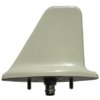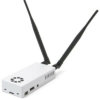JohnAJohnson
Cleared for Takeoff
- Joined
- Aug 14, 2006
- Messages
- 1,323
- Location
- Orange Beach, AL
- Display Name
Display name:
JohnAJohnson
I really don’t think this matters. Many receivers are dual-band, and have a single antenna for both bands.Just make sure you have two 1090Mhz receivers connected to the 1090Mhz antenna or two 978Mhz receivers connected to the 978Mhz antenna rather than mixing and matching 978Mhz and 1090Mhz receivers/antennas.
NO, NO, NO. Almost all ADSB GPS antennas are "active" which means that they need power (generally +5 volts dc) to operate. THerefore, connecting the +5 lines from two separate receivers together is almost sure to destroy the one that is only millivolts below the other one. THe odds of them both being PRECISELY 5 volts is about the same odds as winning an argument with an umpire, the FAA, or your wife. Not necessarily in that order. Splitters like that are prohibitively expensive. I've got one due out in a few months that should go for $50 or so, but it is not yet been proven in service.
Jim
Wow. Y'all don't get it, do you? The INPUT to an ADSB unit is the GPS antenna that needs 5 volts to run the antenna. Connect two GPS receivers together with an adder that connects their inputs together is going to blow one of them up. The coax contains BOTH the RF GPS signal AND the DC voltage to run the antenna. Will somebody that knows what the hell I'm talking about PLEASE come on here and verify what I'm trying to tell the OP?
Wow. Y'all don't get it, do you? The INPUT to an ADSB unit is the GPS antenna that needs 5 volts to run the antenna. Connect two GPS receivers together with an adder that connects their inputs together is going to blow one of them up. The coax contains BOTH the RF GPS signal AND the DC voltage to run the antenna. Will somebody that knows what the hell I'm talking about PLEASE come on here and verify what I'm trying to tell the OP?
Jim

My portable ADS-B receiver has 2 antennas. An internal GPS receiver antenna and a removable RF antenna for reception of 978 and 1090 MHz signals (see image below). It sounds like the OP is asking if the RF in connections of 2 ADS-B receivers can be supplied by a single 978/1090 MHz antenna. I don't think he is asking anything about the GPS antenna.
Does that change anything about what you are saying (writing)?
NO, NO, NO. Almost all ADSB GPS antennas are "active" which means that they need power (generally +5 volts dc) to operate. THerefore, connecting the +5 lines from two separate receivers together is almost sure to destroy the one that is only millivolts below the other one. THe odds of them both being PRECISELY 5 volts is about the same odds as winning an argument with an umpire, the FAA, or your wife. Not necessarily in that order. Splitters like that are prohibitively expensive. I've got one due out in a few months that should go for $50 or so, but it is not yet been proven in service.
Jim
Wow. Y'all don't get it, do you? The INPUT to an ADSB unit is the GPS antenna that needs 5 volts to run the antenna. Connect two GPS receivers together with an adder that connects their inputs together is going to blow one of them up. The coax contains BOTH the RF GPS signal AND the DC voltage to run the antenna. Will somebody that knows what the hell I'm talking about PLEASE come on here and verify what I'm trying to tell the OP?
Jim
My portable ADS-B receiver has 2 antennas. An internal GPS receiver antenna and a removable RF antenna for reception of 978 and 1090 MHz signals (see image below). It sounds like the OP is asking if the RF in connections of 2 ADS-B receivers can be supplied by a single 978/1090 MHz antenna. I don't think he is asking anything about the GPS antenna.
Does that change anything about what you are saying (writing)?

The Stratux I built has two antennae... one for 1090 and one for 978.. and they feed the two SDR USB dongles. Nothing about any of that has anything to do with GPS. The GPS, and AHRS, that I added as options during the build, were their own dongles, and the GPS antenna was built into the GPS dongle. Works fine. I guess my question is why would you want/need TWO adsb-in receivers? For most of them, you can read the data via wifi coming from the receiver on as many devices as you wish...?
That is the input to an ADS-B OUT transmitter. The OP is talking about an ADS-B IN receiver. No GPS antenna should be involved.Wow. Y'all don't get it, do you? The INPUT to an ADSB unit is the GPS antenna that needs 5 volts to run the antenna. Connect two GPS receivers together with an adder that connects their inputs together is going to blow one of them up. The coax contains BOTH the RF GPS signal AND the DC voltage to run the antenna. Will somebody that knows what the hell I'm talking about PLEASE come on here and verify what I'm trying to tell the OP?
...why would you want/need TWO adsb-in receivers?
The device in the first post looks more like a tee (or y) connector than a true power splitter. This may work, but a power splitter will maintain correct 50 ohm impedances and also provide about 20dB isolation between the two receivers. An example of a suitable power splitter is here:
https://www.minicircuits.com/WebStore/dashboard.html?model=ZFSC-2-5+
I wish I didn't, but more and more, we're seeing closed, proprietary ADS-B IN systems that'll only feed its own manufacturing line. So for instance, if I want to have traffic and weather displayed on a G3X, I'd need a Garmin brand receiver. And if I wanted to have traffic and weather displayed on non Garmin Pilot tablet software, I'd need something else like a Stratux, and if I wanted it displayed on a Dynon HDX, I'd need their receiver, ad nauseam.
I don't want to muddy up the waters with the "Why" though. I know there are workarounds to the above, but my point is valid. As tax payers who funded capstone and the GDL90 protocol, we shouldn't be accepting of this walled garden method of forced brand loyalty.
I can't figure out how this device is powered. Do you know?
Wow. Y'all don't get it, do you? The INPUT to an ADSB unit is the GPS antenna that needs 5 volts to run the antenna. Connect two GPS receivers together with an adder that connects their inputs together is going to blow one of them up. The coax contains BOTH the RF GPS signal AND the DC voltage to run the antenna. Will somebody that knows what the hell I'm talking about PLEASE come on here and verify what I'm trying to tell the OP?
Jim




If I misunderstood his post, then I stand corrected. If there is NO GPS and NO transponder involved and you are willing to have the antenna input circuit on #1 affect the signal strength at #2, then gopher it. I have never had any decent luck connecting the inputs of two receivers together without SOME sort of isolation between the two, but if you want to try it I can not see any reason why. THe caveat is that there is NO dc voltage on the input connectors of EITHER receiver.
JIm
I also don’t like and haven’t had much luck with splitting receivers across one antenna other than very expensive perfectly engineered pre-amp and filter systems typically seen on the ground, and nowhere near an aircraft.
I wish I didn't, but more and more, we're seeing closed, proprietary ADS-B IN systems that'll only feed its own manufacturing line.
It's a nuisance even within the same manufacturing line. I wish Garmin made an ADS-B IN only receiver, to feed a Flightstream 210. My ADS-B Out needs are already handled with the 330ES transponder.
My only choice seems to be use the "cheap" half of the expensive GDL88 and not use the Out functionality ($4K to do the job of a $200 Stratux or GDL50). Or keep the little portable Stratux or GDL50 in parallel with the FS210 and suffer the digital tumbleweed of cables everywhere and I suppose the need for two wireless connections to the iPad.
Ernest Wilkinson taught us (Nov 1960 IEEE Transactions on RF and Microwave) how to make splitters that are "lossless" (over a 3 dB split) and isolated between outputs at least 30 dB.
